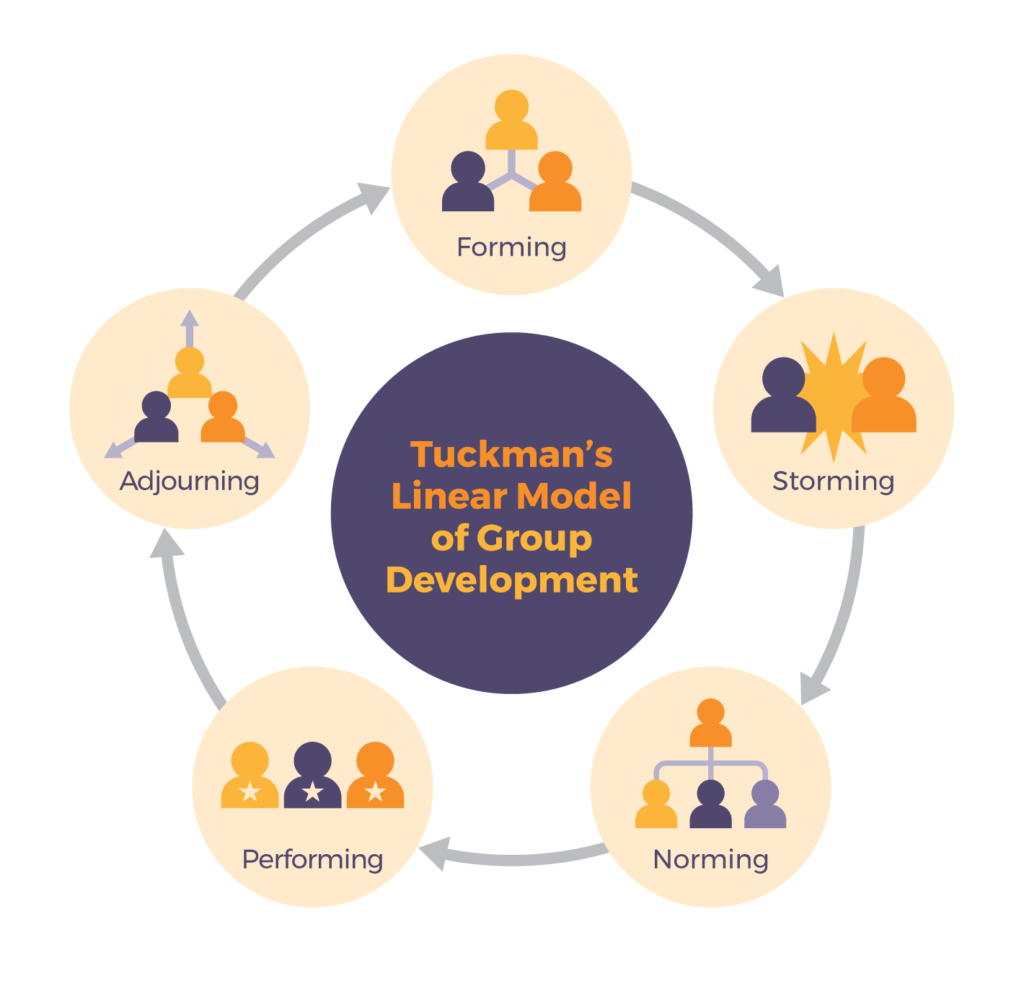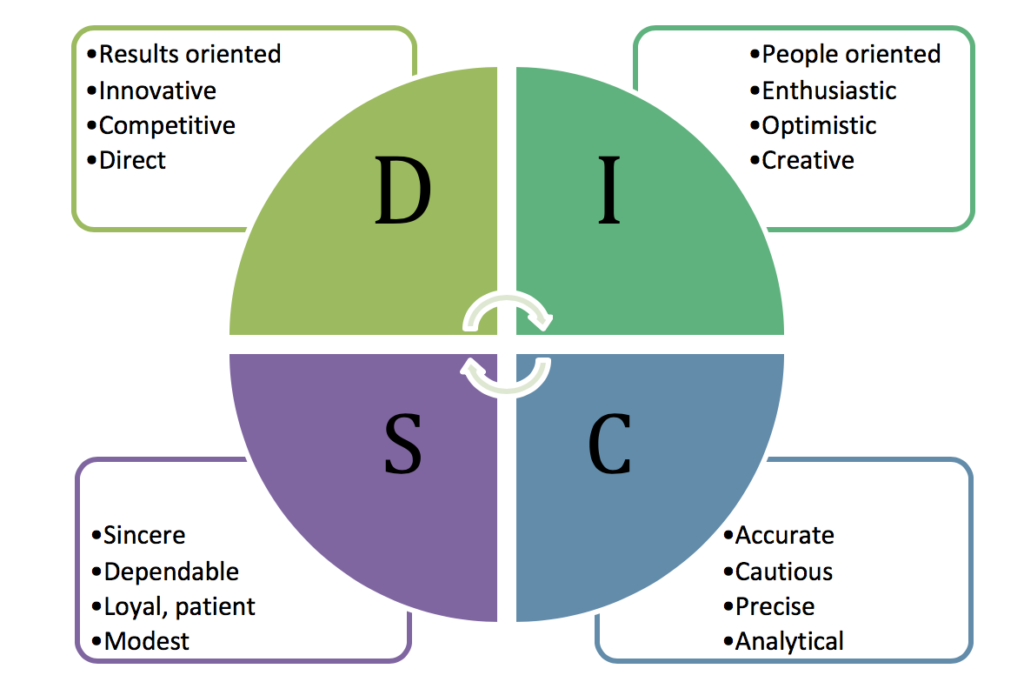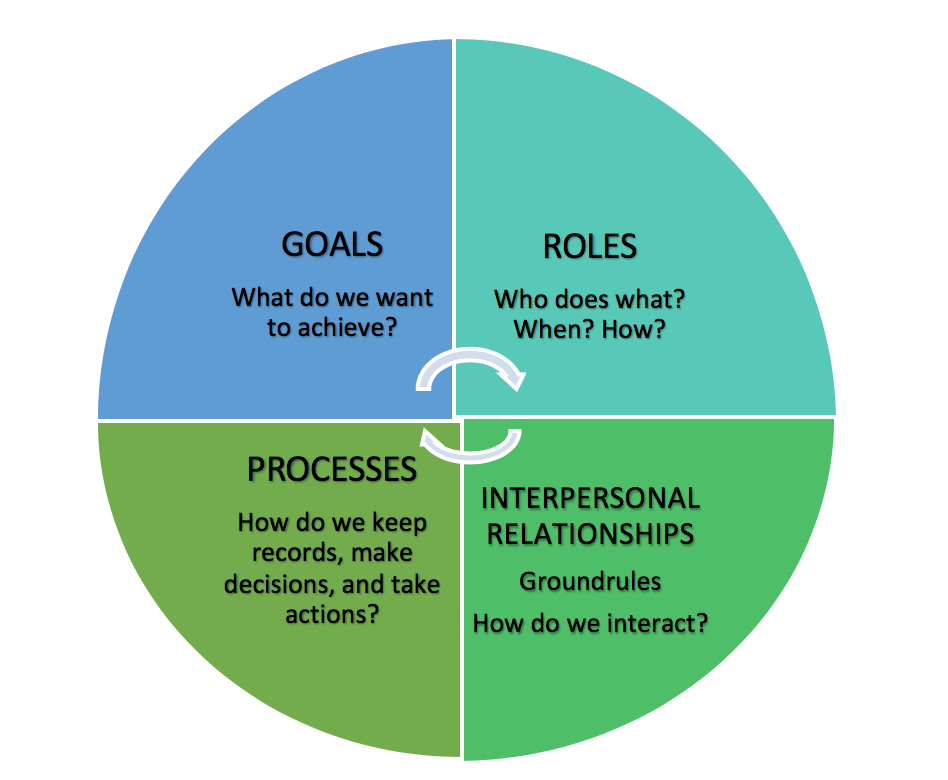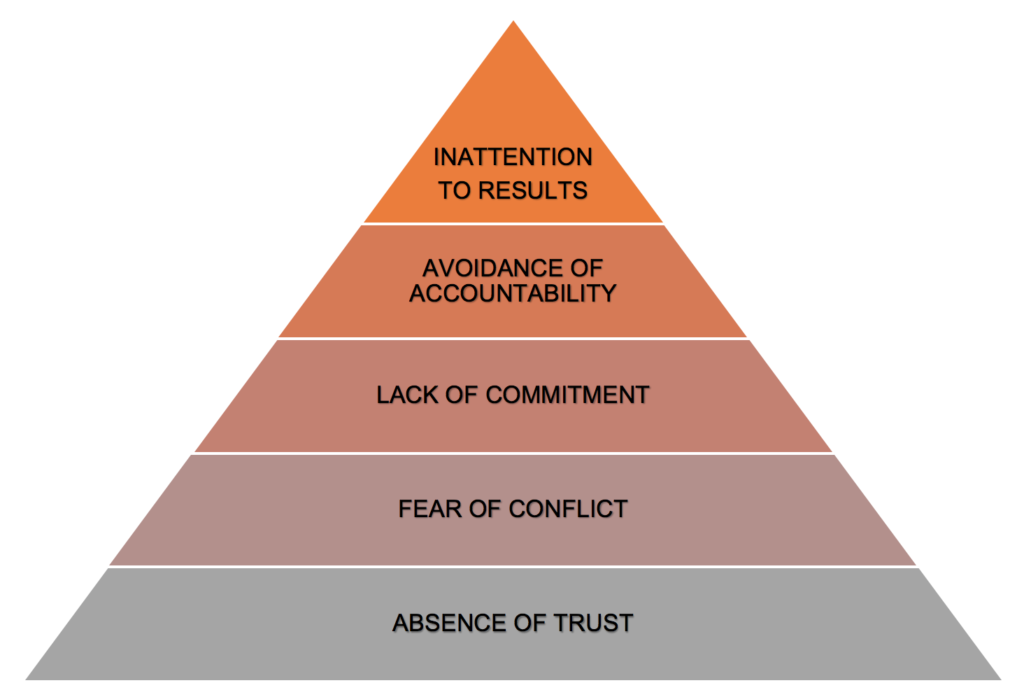4. TEAMWORK AND COMMUNICATION
4.2 Five Models for Understanding Team Dynamics
Suzan Last
An important aspect of effective teamwork entails understanding group dynamics in terms of both team situation and individual temperament. This section reviews a variety models often applied in workplaces that can help a team perform optimally and manage crises effectively.
The Tuckman Team Model
“Tuckman’s Stages of Group Development,” proposed by psychologist Bruce Tuckman in 1965,[1] is one of the most famous theories of team development. It describes four stages that teams may progress through: forming, storming, norming, and performing (a 5th stage was added later: adjourning). According to McCahan et al., the stages move from organizing to producing, and although the stages appear linear, in fact teams may move backwards to previous stages, depending on events that may influence the team and the communications strategies that they use. Some teams can also stall in a stage and never fully realize their potential. Figure 4.2.1 outlines these stages. Please refer to the McCahan et al. text[2] for a more complete discussion.

Figure 4.2.1 The Stages of the Tuckman Model. [3]
Note that at each stage, communication is a critical component of successfully moving to the next stage. The forming stage, when everyone is getting to know each other and are trying to make a good impression, is a good time to create a set of shared expectations, guidelines, or a Team Charter. A team forming activity is also a good idea to help build trust and get to know the various strengths and weaknesses of the team members. This is an orientation stage, on both an interpersonal and professional level, where preliminary boundaries and expectations are established.
The storming stage is the one most often characterized by group conflict. It is often where the preliminary expectations and boundaries are challenged as individuals learn more about each other’s motivations. This coincides with the “brainstorming” stage of the design process, in which each member contributes ideas that could potentially become the focus of the project. It is also the stage where team mates learn about each others’ strengths and weaknesses, and try to determine what their roles will be in the project. Learning to harness the constructive potential of conflict and compromise in this stage is important to progressing to the next stage.
During the norming stage, if conflicts have been resolved and team mates have proved flexible, all is going well, each team member knows their role and works on their part of the project. Sometimes, people work independently in this stage, but check in with team mates frequently to make sure work flow is efficient and effective. Group cohesion ensures that everyone is responsible to the task and to each other; Gantt Charts can be very helpful in keeping everyone on track during this stage. Problems might arise at this stage if teammates do not fully understand their role, the team expectations, or the overall goal; revisiting the forming or storming stage may be required.
Few first-time teams reach the performing stage, as this happens when teams have worked together well on several projects, have established a synergy, and have developed systems that that make projects go smoothly and efficiently. Less time is needed to form, storm and learn to norm; performing teams can move quickly and interdependently to tackling the task at hand. Adjourning and going their separate ways can often be somewhat emotional for these teams. Figure 4.2.2[4] depicts the trajectory of each team member during each stage.
![DIogo Nicoleti [CC BY-SA 4.0 (https://creativecommons.org/licenses/by-sa/4.0)], from Wikimedia Commons Forming: 4 arrows pointing to the centre. Storming, 4 arrows going in various random directions. Norming: 4 arrows going in almost the same direction. Performing: 4 arrows perfectly aligned. Adjourning: 4 arrows pointing outward from the centre in the 4 cardinal directions.](https://pressbooks.bccampus.ca/technicalwriting/wp-content/uploads/sites/296/2018/05/Screen-Shot-2018-11-24-at-1.40.42-PM-1024x247.png)
DISC Model
DISC theory, developed in 1928 by Dr. William Moulton Marston (who also, as it happens, created the Wonder Woman comic series!), has evolved into a useful model for conflict management as it predicts behaviours based on four key personality traits he originally described as Dominance, Inducement, Submission, and Compliance.[5] The names of these four traits have been variously revised by others over the decades, so you might find different terms used in different contexts. The four general traits are now often described as (1) Dominance, (2) Influence/Inspiring (3) Steadiness/Supportive, and (4) Compliance/Conscientiousness (see Figure 4.2.3).

Industries often use DISC assessments in professional contexts. Having some insight into your teammates’ personality traits can help when trying to resolve conflicts. General characteristics of each trait are as follows:
- Dominance
- Characteristics: direct, decisive, ego-driven, problem-solver, and risk-taker; likes new challenges and freedom from routine; driven to overcome obstacles
- Strengths: great organizer and time manager; challenges the status quo; innovative
- Weaknesses: can be argumentative, disrespectful of authority, and overly ambitious (taking on too much); can be blunt, stubborn, and aggressive
- Inspiring/Influential
- Characteristics: enthusiastic, persuasive, optimistic, trusting, impulsive, charismatic, and emotional
- Strengths: creative problem solver; great cheer-leader, negotiator, and peace-maker; a real “people person”
- Weaknesses: more concerned with popularity than tangible results; lacks attention to detail
- Steady/Supportive
- Characteristics: reliable, predictable, friendly, good listener, team player, empathetic, easy-going, and altruistic.
- Strengths: dependable, loyal; respects authority; has patience and empathy; good at conflict resolution; willing to compromise.
- Weaknesses: resistant to change; sensitive to criticism; difficulty prioritizing
- Cautious/Conscientious/Compliant
- Characteristics: has high standards; values precision and accuracy; analytical and systematic; even-tempered, realistic, and logical; methodical; respect for authority
- Strengths: great information gatherer/researcher; able to define situations precisely and accurately; offers realistic perspective
- Weaknesses: can get bogged down in details; needs clear boundaries, procedures, and methods; difficulty accepting criticism; may avoid conflict or just “give in.” May be overly timid.
GRIP Model
Richard Beckhard’s GRPI model,[6] originally developed in 1972, has been widely adapted in sports contexts as the GRIP model (see Figure 4.2.4), outlining four interrelated components of highly effective teamwork:
- Goals: everyone must fully understand and be committed to the goals of the team, and of the organization. Everyone’s goals must be aligned in order to establish trust, make progress, and achieve desired outcome.
- Roles: all team members must know what part they play, what is expected, and how they are held accountable and responsible.
- Interpersonal: quality communication and collaboration require and foster trust among team members; sensitivity and flexibility needed to deal with conflict and make progress.
- Processes: defined system for how decisions are made, how the team solves problems and addresses conflict; defines work flow and procedures to be followed in completing the project.

Thomas-Kilmann Conflict Mode Model
Thomas and Kilmann’s model[7] for handling team conflict outlines five main approaches to managing team conflict (Competing, Accommodating, Compromising, Avoiding, and Collaborating), placed in a matrix of two scales: Assertiveness—the degree to which one tries to meet one’s own needs; and Cooperativeness—degree to which one tries to satisfy the needs of other team members (See illustration).
Each approach can have both positive and negative impacts:
- Competing: highly assertive, but uncooperative behaviour, characterized by the urge to “win at all costs,” dominate, and engage in power struggles. This can result in animosity, but can also spur teammates to compete constructively, which can lead to interesting innovations if well managed.
- Accommodating: highly cooperative, but unassertive behaviour. This may seem like a good way to avoid conflict, but it can also lead to self-silencing of good ideas in order to appease others, which may lead to feelings of resentment.
- Compromising: this approach is the most moderate in both scales, and while it might seem constructive, it can lead to dissatisfaction and mediocre progress or results. Sometimes compromise is necessary, but often, the best solution comes from a single inspirational source.
- Avoiding: being unassertive and uncooperative is generally the least effective way to deal conflict, as this simply avoids the problem and neglects the need for a solution. However, when a feasible solution to a problem seems impossible, sometimes ignoring it and focusing on what is good can be the best way to just get through it.
- Collaborating: being highly assertive and cooperative is the best way to find solutions that benefit the whole team and build respect.
Lencioni Model
In his 2005 book, The Five Dysfunctions of a Team, Lencioni[8] outlines five common problems teams experience that impact their effectiveness:
- Lack of trust: if team members do not trust each other, they are unlikely to take risks or ask for help. A lack of trust means a low level of comfort that makes it difficult to communicate and perform effectively as a team
- Fear of conflict: avoiding conflict can lead to an artificial “peace” at the expense of progress and innovation. Conflict is a normal part of team work and can be very productive if managed effectively.
- Lack of commitment: team members do not commit to doing the work, do not follow through on decisions or tasks, do not meet deadlines, and let their teammates down, ultimately affecting the success of the whole project.
- Avoidance of accountability.
- Inattention to results: when team members focus on their own personal goals instead of project goals, they lose sight of the expected results that actually measure the success of the project. Not focusing on the results during the process means that no one is planning how to improve those results.

Figure 4.2.5 Lencioni Model: Five Dysfunctions of a Team
Lencioni advises tackling each dysfunction, displayed in the pyramid in Figure 4.2.5, from the bottom up. Establishing trust is a crucial first step to being able to manage conflict, achieve commitment, create accountability and focus on results.
EXERCISE 4.2 Apply these models to your experience
Apply one or more of these models to your past or current experience of teamwork:
- Have you engaged in the Tuckman team formation steps?
- Can you determine which of the DISC characteristics most closely matches your personality traits?
- Have you experienced a team project where misaligned goals or unclear roles had a negative impact?
- Do you think learning about the conflict modes or typical dysfunctions can help make your future team experiences more productive?
- Could you propose an alternative model for effective teamwork?
- B. Tuckman, "Developmental sequence in small groups," Psychological Bulletin, vol. 63, no. 6, pp. 384-399. Available: http://dx.doi.org/10.1037/h0022100 : ↵
- S. McCahan, P. Anderson, M. Kortschot, P. E. Weiss, and K. A. Woodhouse, “Introduction to teamwork,” in Designing Engineers: An Introductory Text, Hoboken, NJ: Wiley, 2015, pp. 219-246. ↵
- eCampus Ontario. “Tuckman’s Linear Model of group development”, in Communication for Business Professionals - Canadian Edition [Online]. eCampus Ontario, 2018. Available: https://ecampusontario.pressbooks.pub/commbusprofcdn/. CC-BY-SA. ↵
- Dlogo Nicoleti. “Modelo de Tuckman.png”, Wikimedia Commons, https://commons.wikimedia.org/wiki/File:Modelo_de_Tuckman.png . CC BY-SA 4.0 . ↵
- W. M. Marsten, Emotions of Normal People. Keegan Paul Trench Trubner and Co. Ltd., 1928; republished London: Routledge, 2002 ↵
- R. Beckhard, (1972). “Optimizing team building efforts,” Journal of Contemporary Business, 1972, pp. 23–27. ↵
- K. W. Thomas & R. H. Kilmann, “Thomas–Kilmann Conflict Mode Instrument,” Tuxedo NY: Xicom, 1974. ↵
- P. Lencioni, Five Dysfunctions of a Team, New York, NY: John Wiley and Sons Inc., 2002. ↵

